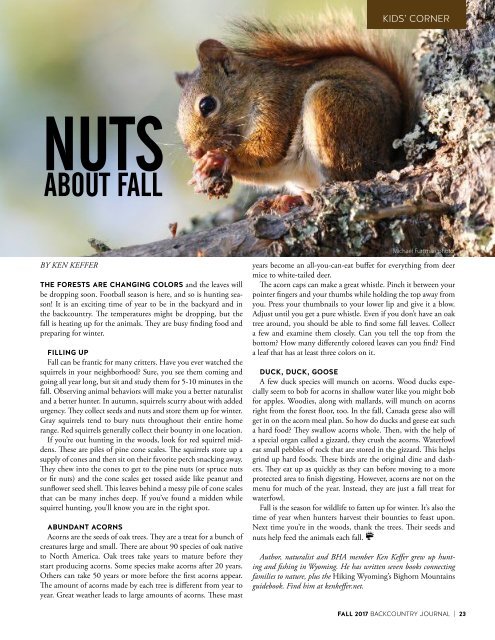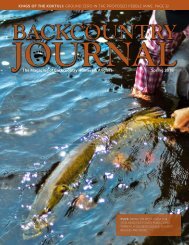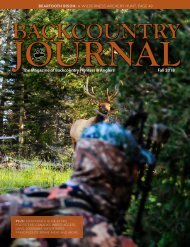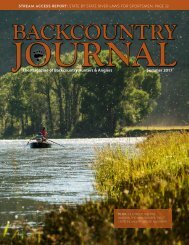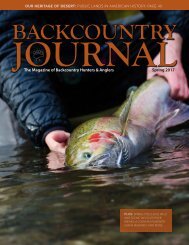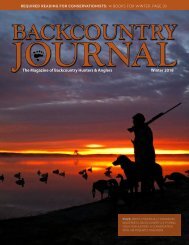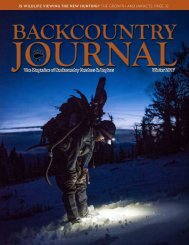BCJ_FALL17 Digital Edition
Create successful ePaper yourself
Turn your PDF publications into a flip-book with our unique Google optimized e-Paper software.
KIDS’ CORNER<br />
NUTS<br />
ABOUT FALL<br />
Michael Furtman photo<br />
BY KEN KEFFER<br />
THE FORESTS ARE CHANGING COLORS and the leaves will<br />
be dropping soon. Football season is here, and so is hunting season!<br />
It is an exciting time of year to be in the backyard and in<br />
the backcountry. The temperatures might be dropping, but the<br />
fall is heating up for the animals. They are busy finding food and<br />
preparing for winter.<br />
FILLING UP<br />
Fall can be frantic for many critters. Have you ever watched the<br />
squirrels in your neighborhood? Sure, you see them coming and<br />
going all year long, but sit and study them for 5-10 minutes in the<br />
fall. Observing animal behaviors will make you a better naturalist<br />
and a better hunter. In autumn, squirrels scurry about with added<br />
urgency. They collect seeds and nuts and store them up for winter.<br />
Gray squirrels tend to bury nuts throughout their entire home<br />
range. Red squirrels generally collect their bounty in one location.<br />
If you’re out hunting in the woods, look for red squirrel middens.<br />
These are piles of pine cone scales. The squirrels store up a<br />
supply of cones and then sit on their favorite perch snacking away.<br />
They chew into the cones to get to the pine nuts (or spruce nuts<br />
or fir nuts) and the cone scales get tossed aside like peanut and<br />
sunflower seed shell. This leaves behind a messy pile of cone scales<br />
that can be many inches deep. If you’ve found a midden while<br />
squirrel hunting, you’ll know you are in the right spot.<br />
ABUNDANT ACORNS<br />
Acorns are the seeds of oak trees. They are a treat for a bunch of<br />
creatures large and small. There are about 90 species of oak native<br />
to North America. Oak trees take years to mature before they<br />
start producing acorns. Some species make acorns after 20 years.<br />
Others can take 50 years or more before the first acorns appear.<br />
The amount of acorns made by each tree is different from year to<br />
year. Great weather leads to large amounts of acorns. These mast<br />
years become an all-you-can-eat buffet for everything from deer<br />
mice to white-tailed deer.<br />
The acorn caps can make a great whistle. Pinch it between your<br />
pointer fingers and your thumbs while holding the top away from<br />
you. Press your thumbnails to your lower lip and give it a blow.<br />
Adjust until you get a pure whistle. Even if you don’t have an oak<br />
tree around, you should be able to find some fall leaves. Collect<br />
a few and examine them closely. Can you tell the top from the<br />
bottom? How many differently colored leaves can you find? Find<br />
a leaf that has at least three colors on it.<br />
DUCK, DUCK, GOOSE<br />
A few duck species will munch on acorns. Wood ducks especially<br />
seem to bob for acorns in shallow water like you might bob<br />
for apples. Woodies, along with mallards, will munch on acorns<br />
right from the forest floor, too. In the fall, Canada geese also will<br />
get in on the acorn meal plan. So how do ducks and geese eat such<br />
a hard food? They swallow acorns whole. Then, with the help of<br />
a special organ called a gizzard, they crush the acorns. Waterfowl<br />
eat small pebbles of rock that are stored in the gizzard. This helps<br />
grind up hard foods. These birds are the original dine and dashers.<br />
They eat up as quickly as they can before moving to a more<br />
protected area to finish digesting. However, acorns are not on the<br />
menu for much of the year. Instead, they are just a fall treat for<br />
waterfowl.<br />
Fall is the season for wildlife to fatten up for winter. It’s also the<br />
time of year when hunters harvest their bounties to feast upon.<br />
Next time you’re in the woods, thank the trees. Their seeds and<br />
nuts help feed the animals each fall.<br />
Author, naturalist and BHA member Ken Keffer grew up hunting<br />
and fishing in Wyoming. He has written seven books connecting<br />
families to nature, plus the Hiking Wyoming’s Bighorn Mountains<br />
guidebook. Find him at kenkeffer.net.<br />
FALL 2017 BACKCOUNTRY JOURNAL | 23


